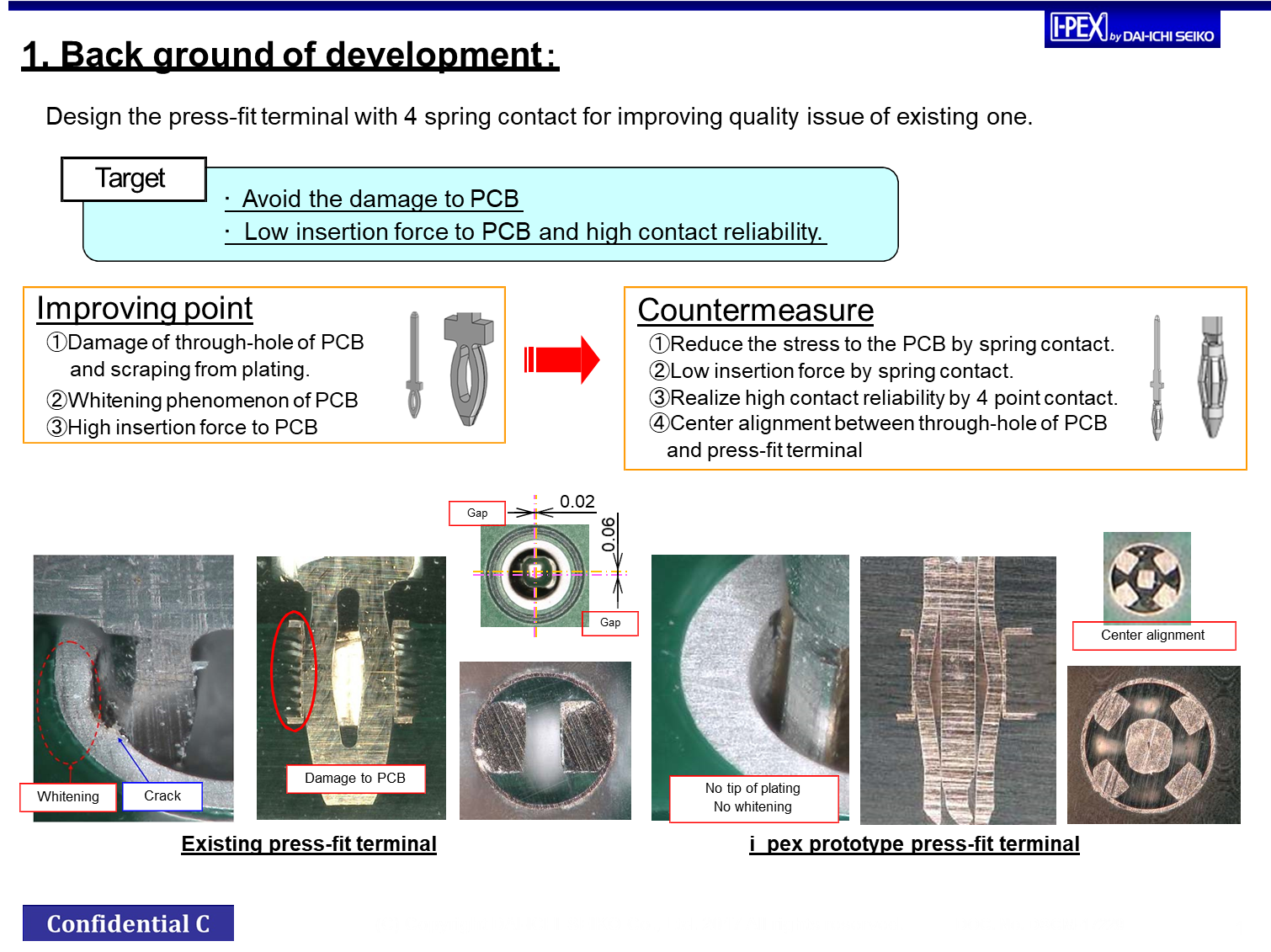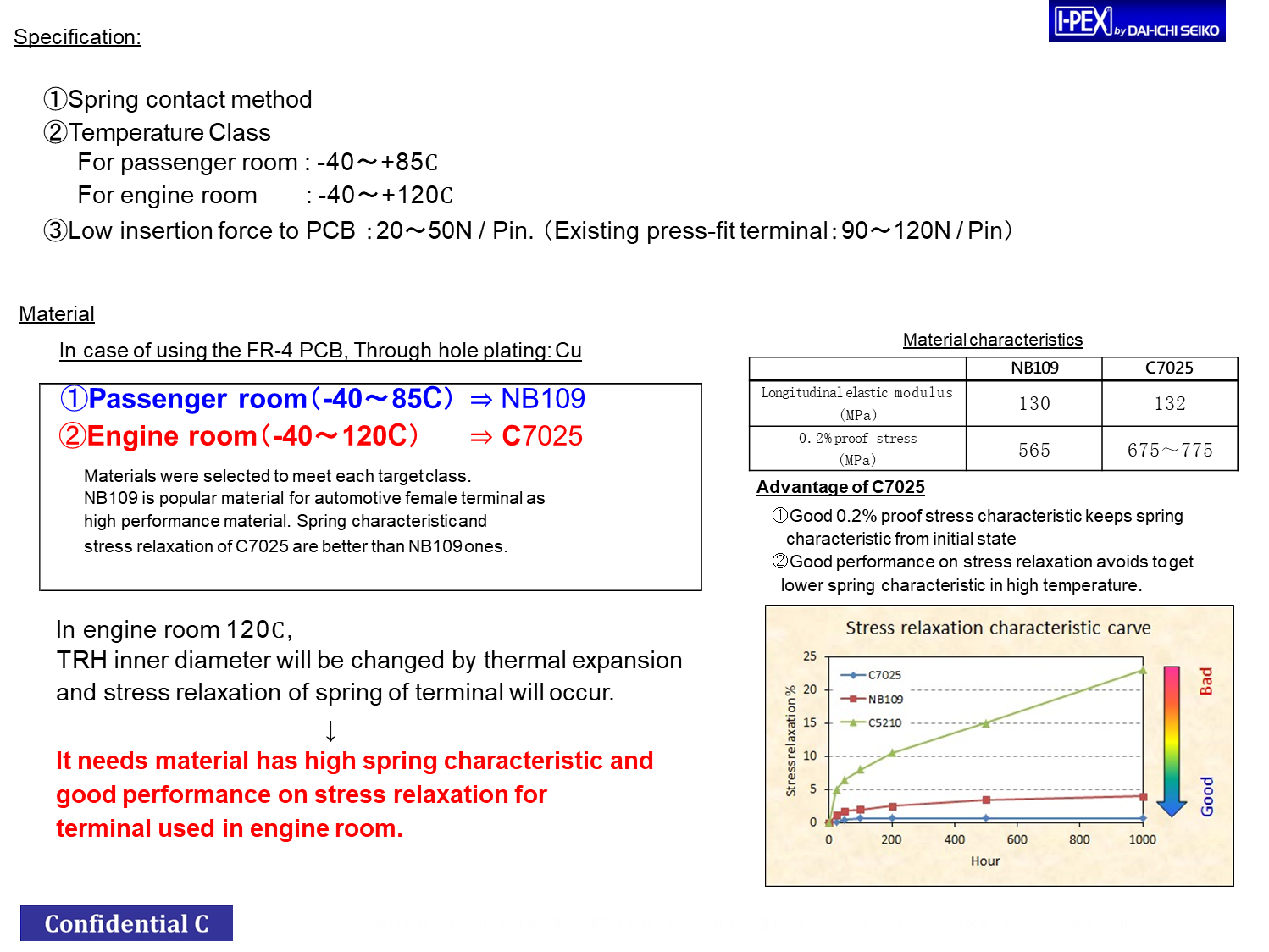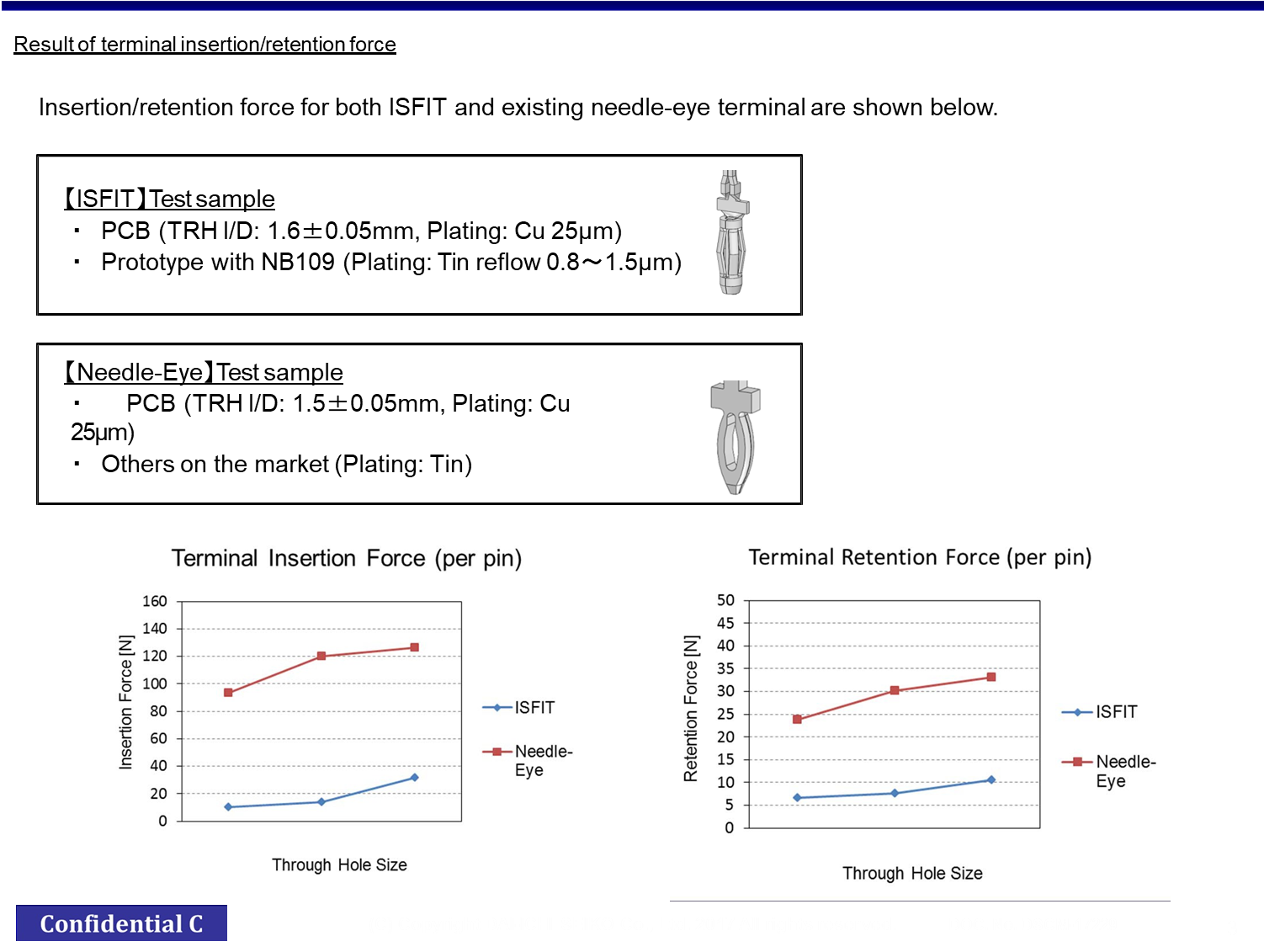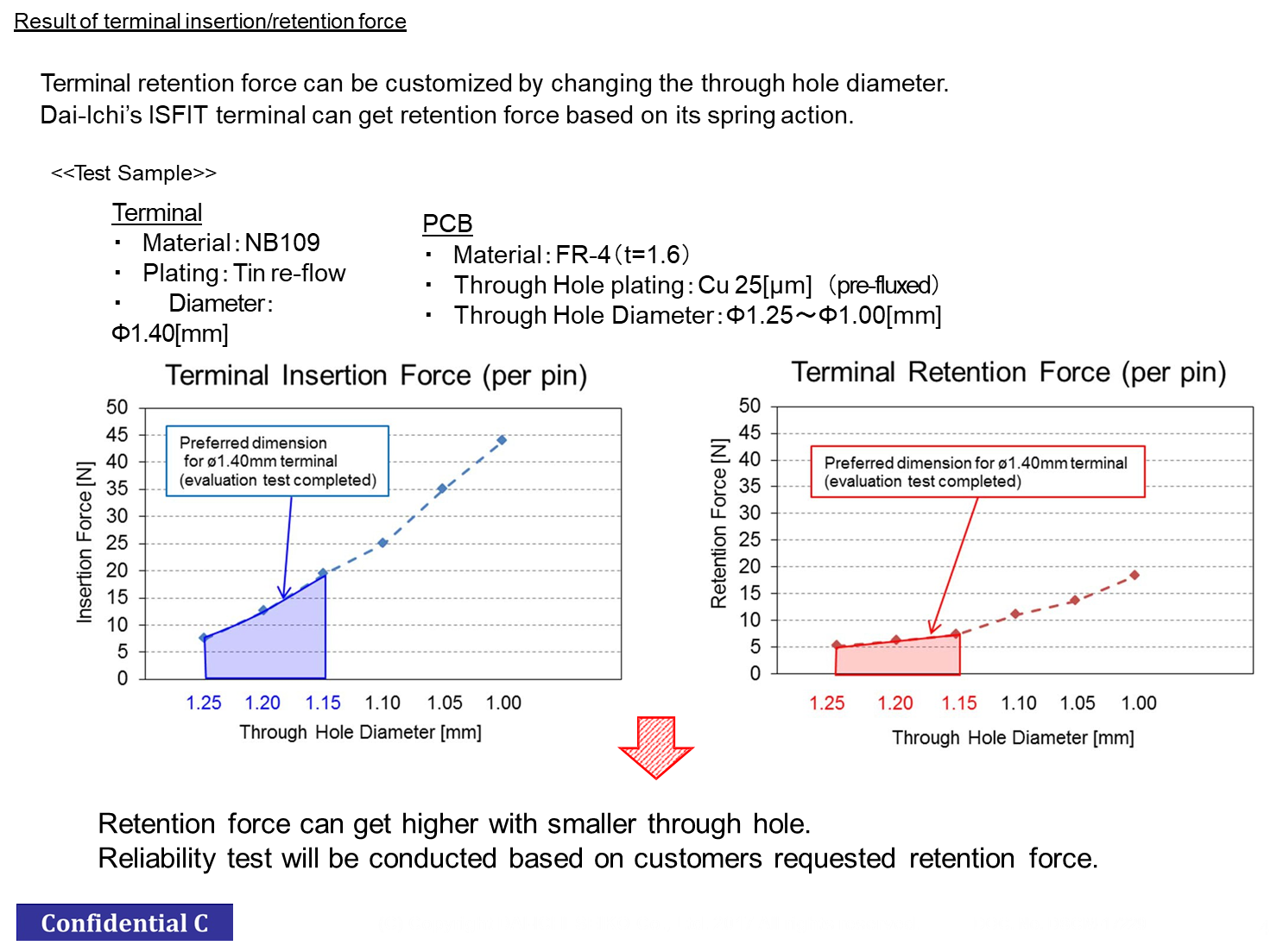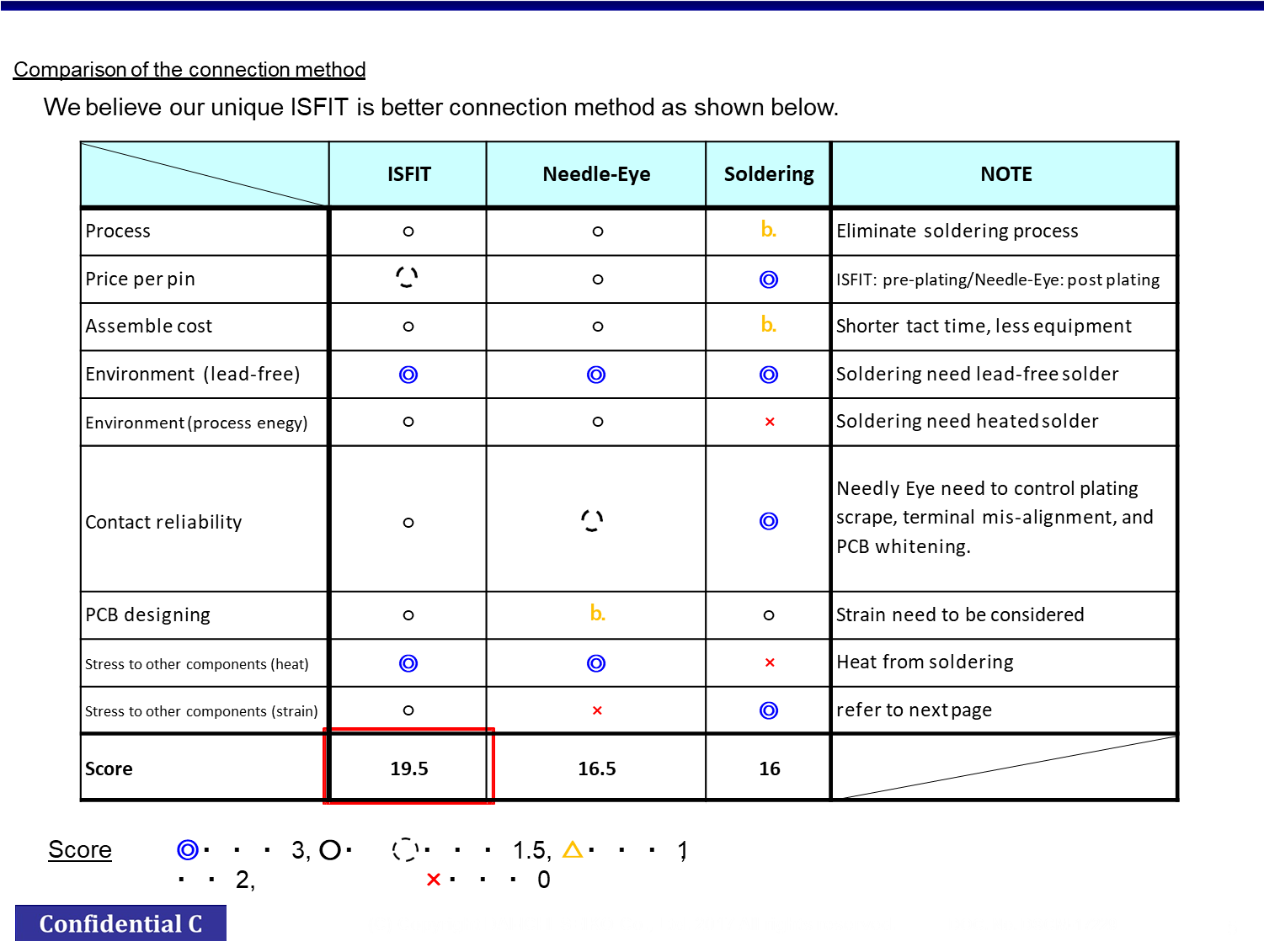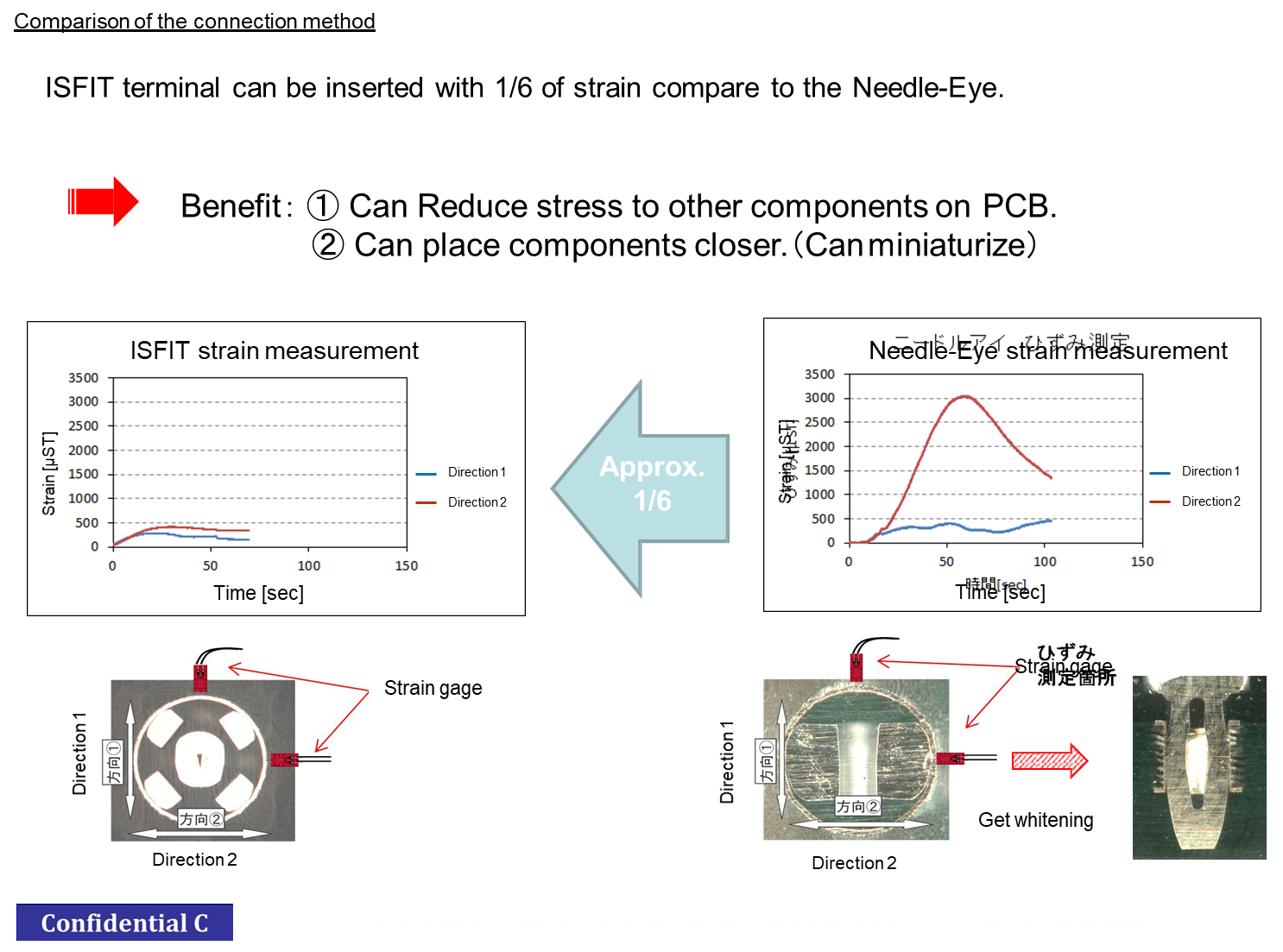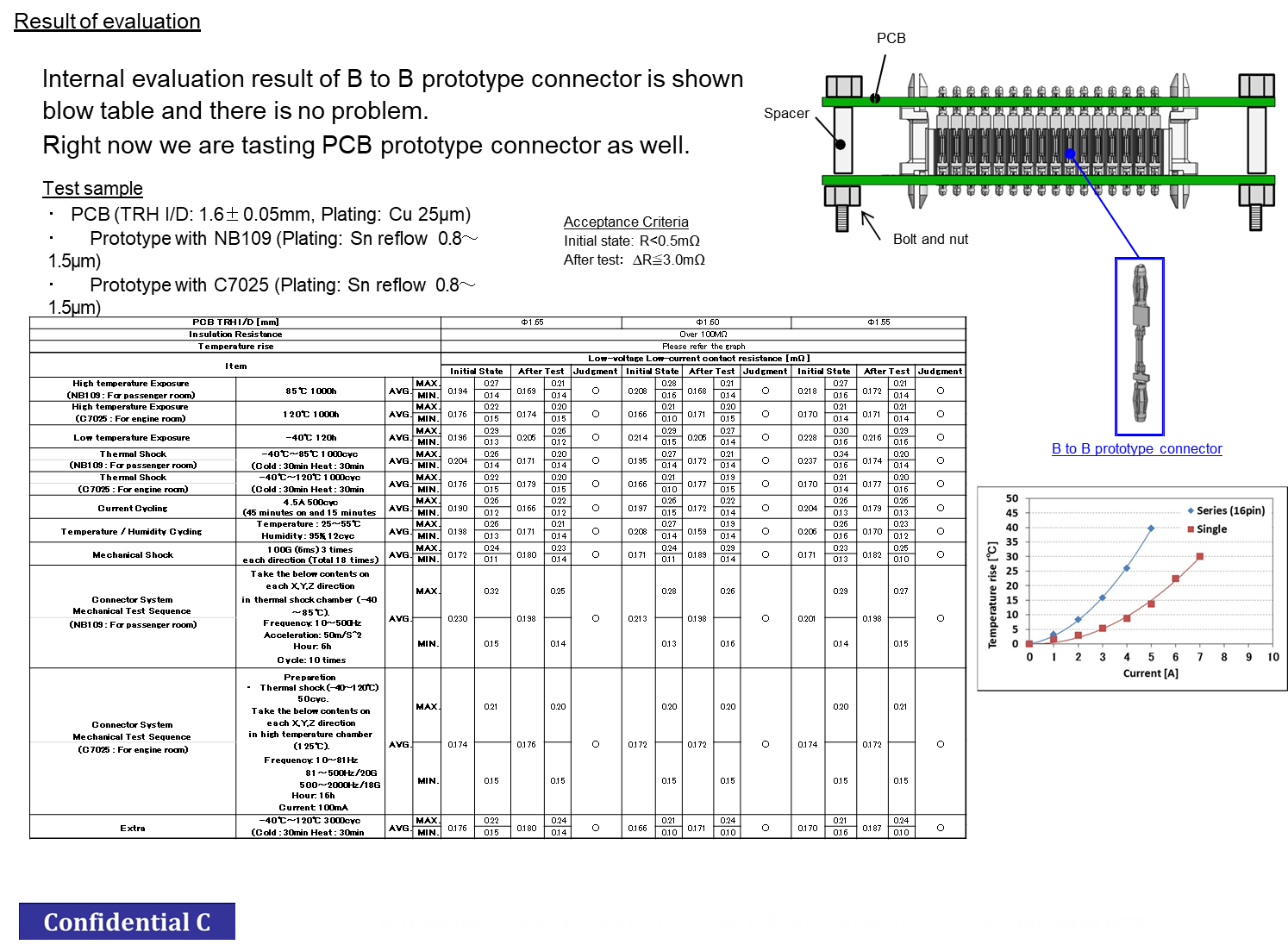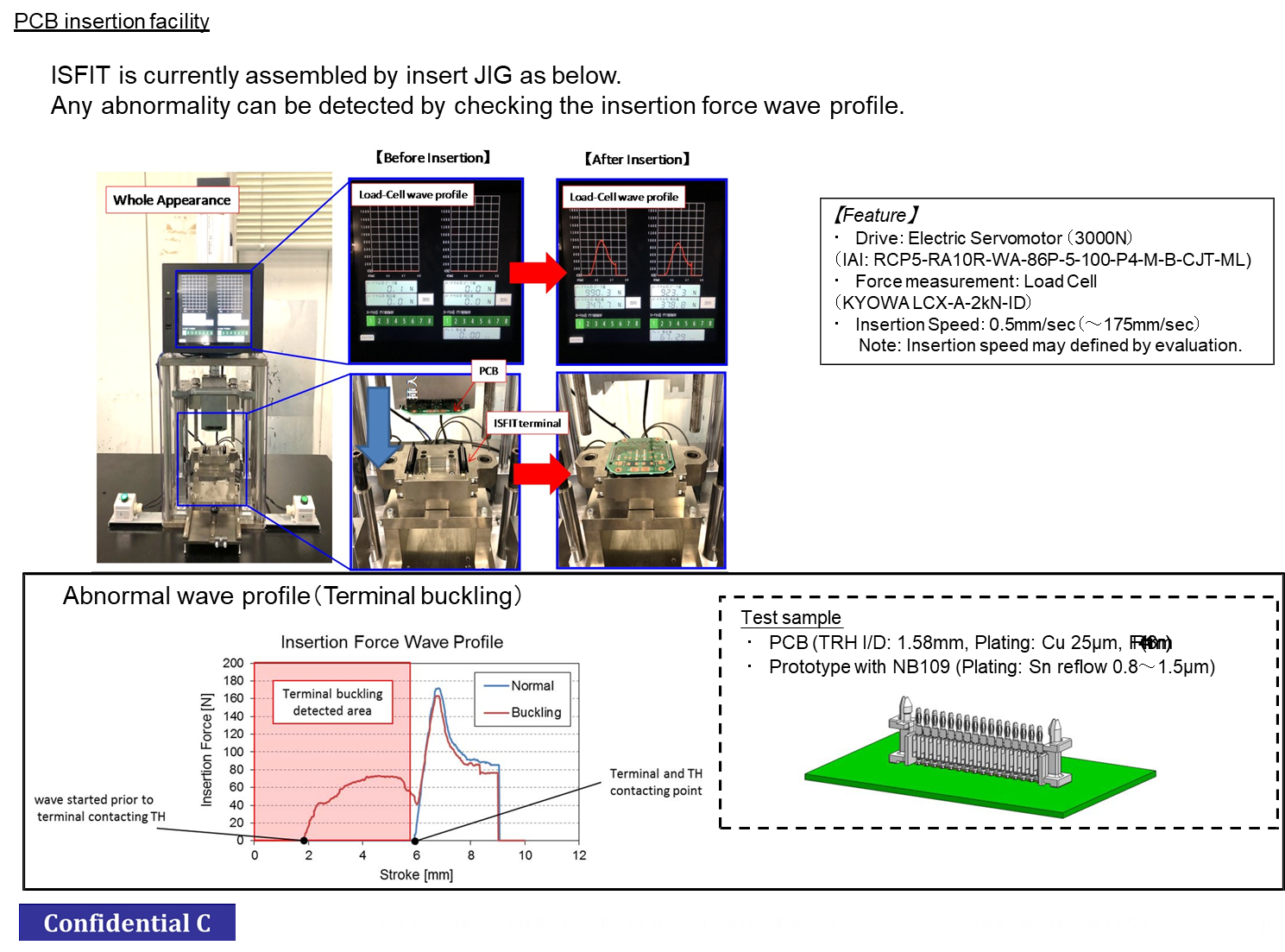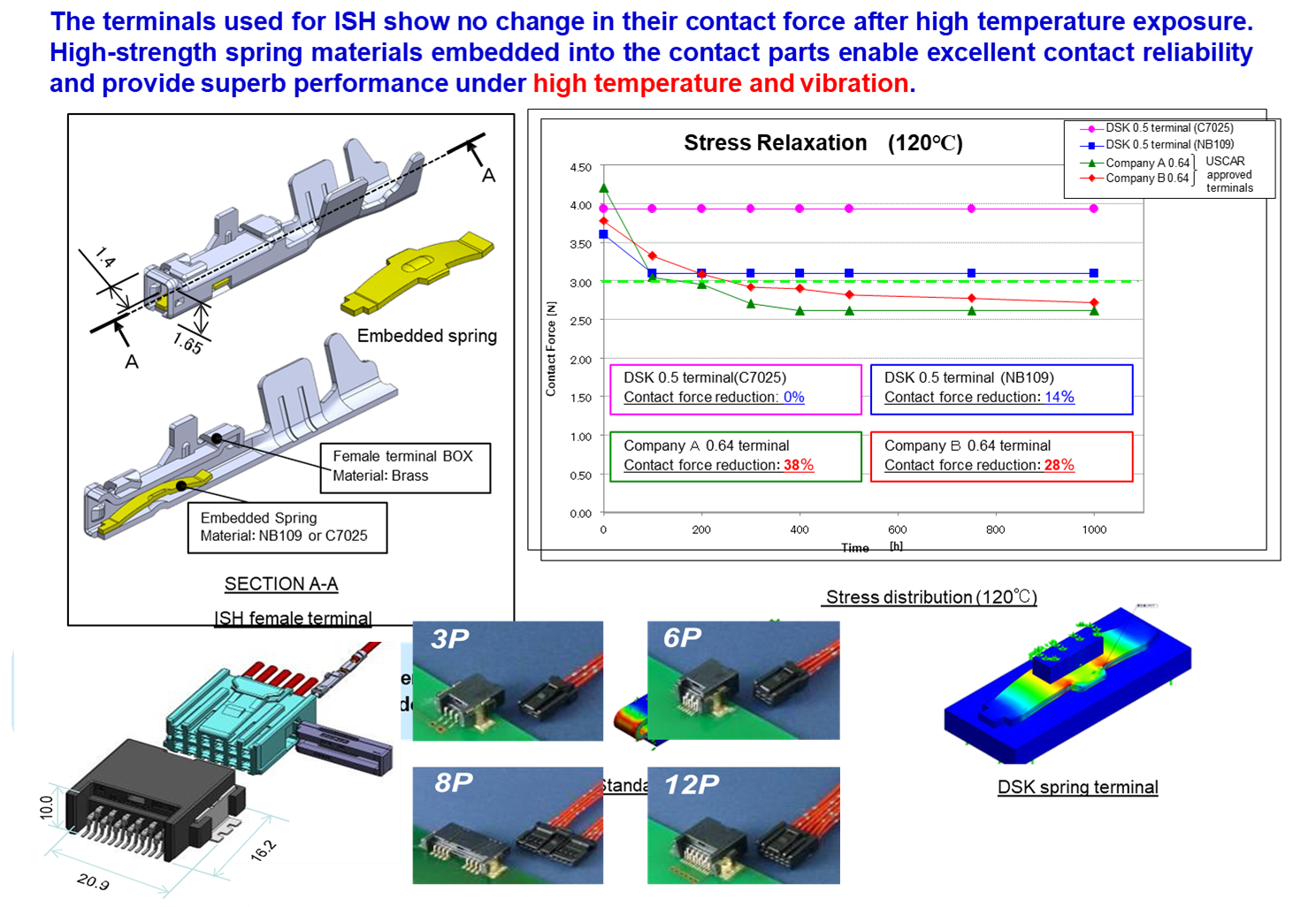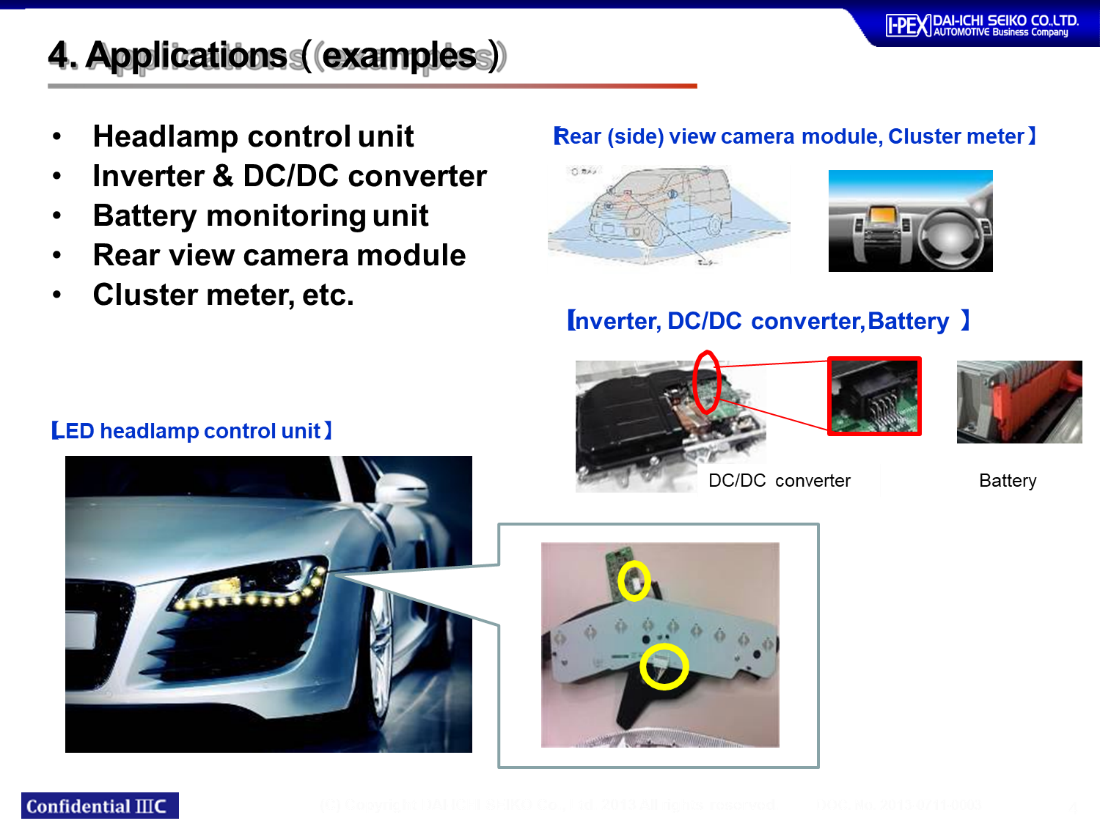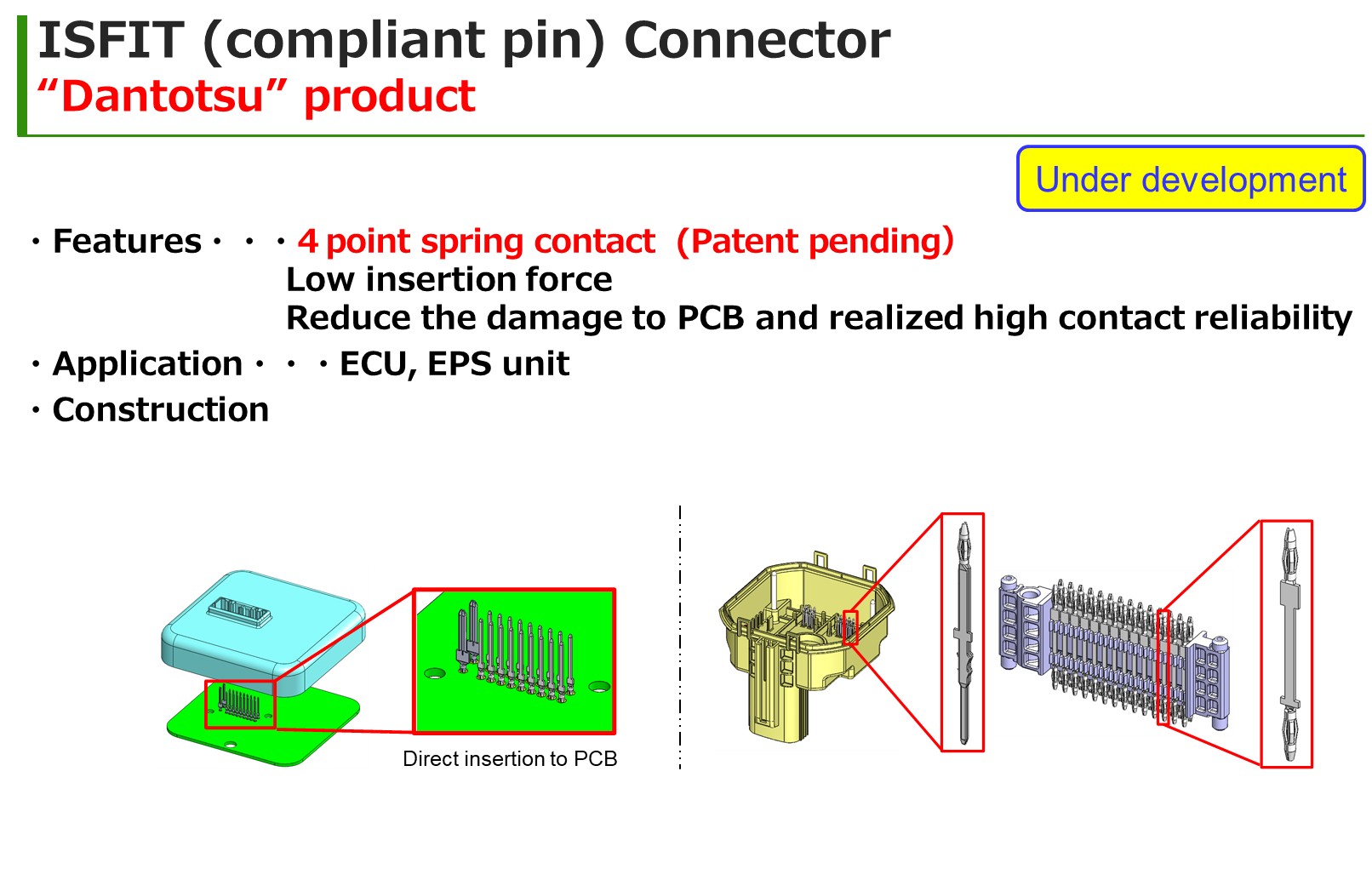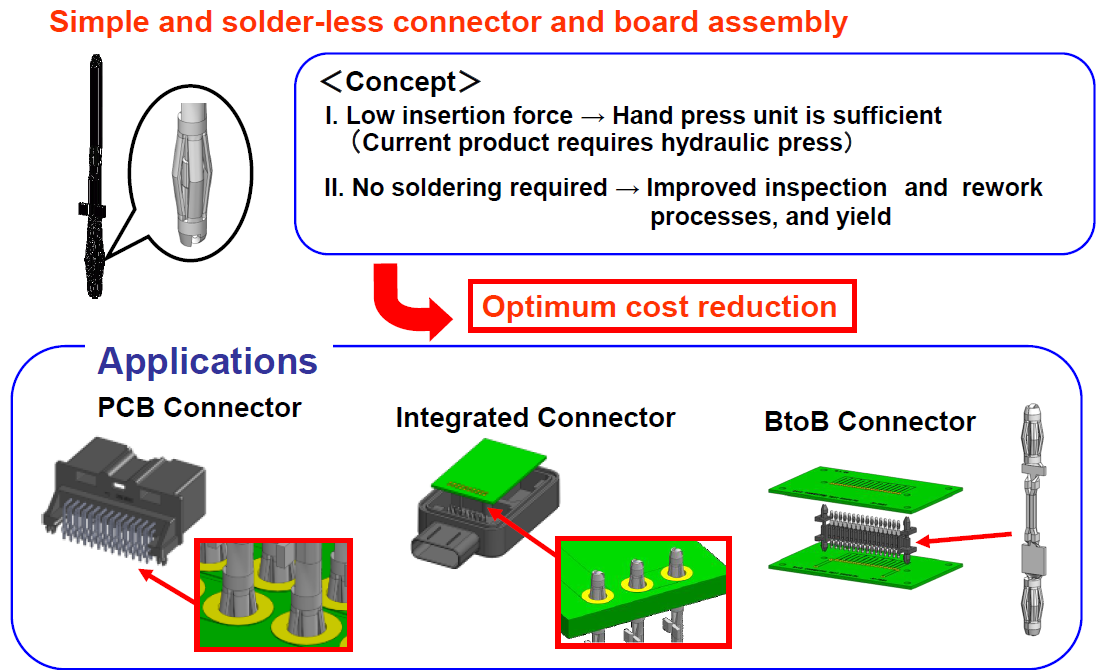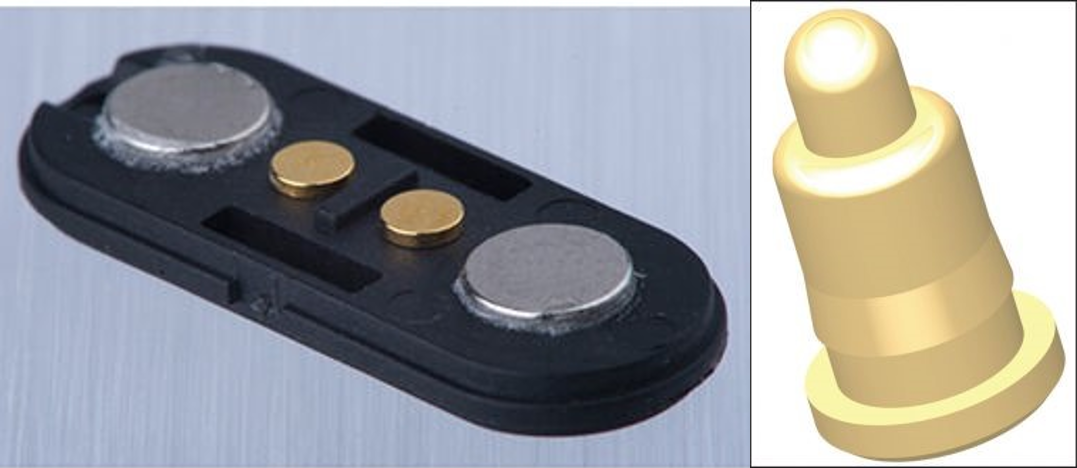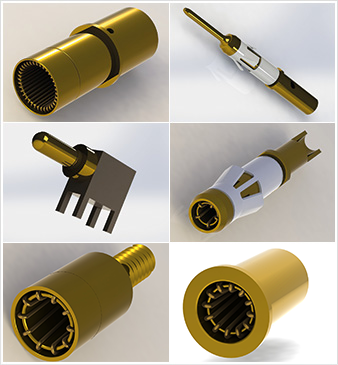Insulation displacement contact and press-fit or compliant pin technology are two more reliable contact systems in critical automotive applications – refer ECN of 08/20.
Per design each contact goes through different levels of both elastic and plastic deformations during the wire or PCB insertion process. Once in the final seated position, both IDC and press-fit contacts apply continuous force to achieve high-contact integrity especially designed to withstand extreme temperatures, shock, vibration, and thermal expansion.
Press-fit pins are inserted into plated-through-holes (PTHs) on PCBs (Figure 2) and, during this process, experience the very same elastic and plastic deformation as wires in IDCs. The unique eye-of-the-needle geometry of press-fit pins and the inherent properties of the phosphor bronze material they’re generally made of provide sufficient flexibility to deform and compress during the insertion process. This flexibility sufficiently prevents any damage or scarring of the PTH, which can jeopardize the long-term reliability of the connection. Once mated, these active, high-opposing-force contact systems adjust as needed to maintain high-integrity connections in even the harshest conditions.
Hand-soldered connector systems can start to fail due to age or solder embrittlement and as such press-fit technology may be better solution.
IDC and press-fit contact systems are also almost always made of phosphor bronze materials, which exhibit superior high-reliability performance characteristics and are available in various grades or compositions (e.g., CuSN6, CuNiSi, and STOL78) that can be adjusted to suit individual end-customer application requirements, including temperature extremes, enhanced conductivity, and challenging tensile or yield strength requirements.
One of the most significant advantages of this innovative new contact system is it eliminates the need for costly two-piece connector systems in demanding, harsh-environment applications that currently rely on elastic-only, spring-force contact systems. These new IDC/press-fit combination connectors were also especially designed with dual-assembly methodologies in mind. They can be pre-installed on PCBs during the board build process, allowing wires to be inserted and pressed into place with any standard flat-rock seating tool upon final assembly, or pre-installed on wire harnesses, allowing them to be pressed into PCBs upon final assembly. This second process is especially suited for use in applications subjected to conformal coating processes, as the PTH pattern can easily be covered with Kapton® or another tape with similar removal properties during the coating process and, post removal, allow the connector harness to simply be pressed into place.
For more information read 08/2018 ECN Magazine.
IARPB Connector (direct mount W to B connector)
Terminal & Connector Assembly suitable for low clearance automotive and other applications.
- 5mm Pitch Board-In Connector Round terminal for soldering.
- Direct insertion to PCB for Automotive.
- Pin size/pitch 2.5mm, DIP dia. ø0.7mm.
- Hanging out terminals from housing make easier insertion and visual verification.
- Vibration proof housing retains well onto PCB.
- Round terminal prevents deformation during shipment and installation.
For more information contact: DAI-ICHI SEIKO LTD.
__________________________________________________________________________________________
ISFIT TERMINAL – I-PEX Automotive SPRING PRESS FIT
I-PEX Press Fit terminals are designed to eliminate both soldering of terminals on PCBA and improve reliability over current high force press fit terminals.
Basic Design Specifications and materials:
As you can see the design and production benefits are:
- Insertion force < 20N per terminal is 75% lower than current needle eye press fit terminals.
- Minimal to no damage to PCBA.
- Eliminates hand soldering which can cause quality and reliability concerns.
- Eliminates scraps from plating common in high insertion force needle eye press fit terminals.
- No high cost press fit equipment needed thus greatly reducing process costs.
For more information please write to designhmi@gmail.com or go to http://www.daiichi-seiko.co.jp.
High Temperature* and Vibration Resistance 0.5mm-Terminal Small Type SMT connector
I-PEX Automotive Surface Mount Technology Heavy Duty Connector reduced occupied area on PCB by 30%, overall height 6.15mm – smallest in the market with potential 25% cost reduction with Sn plating.
Application Examples:
Compliant Ft Low Insertion Terminals for Automotive Applications
We are all aware of press fit terminals and their superior performance and reliability for automotive PCBA to PCBA connection and other applications like connector head. However, usage in North American Automotive assemblies is limited but has high usage in European OE’s for last few years.
One reason of low usage among North American automotive suppliers was the very high insertion force needed for 12+ pin terminal assembly requiring special press fit machine.
Dai-ichi Seiko ISFIT press-fit terminal has developed four-point contact (multi-contact spring) spring structure for the terminal which only utilizes about 1/4 of the force needed to fit when compared general needle-eye type terminals.
Also, potential damage to the substrate and abrasion of the through-hole is reduced. Of course, solderless connection makes it possible to reduce the man-hours for assembly, inspection, etc. with better reliability and quality.
The patented design technology earlier under development is slowly going into production for 20+ PCBA to PCBA connectivity. These PCB Assemblies are two sided and non-soldered terminals allow for easy integration of SMD Components reflow soldered to both sides without secondary operations.
Low insertion force press-fit terminal
ISH Connector has developed thinner micro SMT connector using 0.5 terminal which are resistant to heat and vibration and provides connection reliability for inverters, LED lights, CCD camera modules etc.
The combined type of PCB connectors is based on USCAR/EWCAP standards.
- SMT connector with high temperature and vibration resistance, small size and low profile.
- Small-size SMT connector for automotive application. Terminal size: 0.5 mm Pitch:2.0 mm.
- Superior contact reliability by adaption of 2-part female terminal (body: brass, spring: copper alloy).
- Horizontal-type Single row : 3 pins
- Double rows: 6,12 and 16pins
- Vertical-type.
- Double rows :10 and 20 pins.
High-strength spring material fitted into the terminal’s main brass body provides excellent contact reliability and capability to withstand high temperature and vibration
ISFIT is an automotive press-fit terminal which has been newly developed by Dai-ichi Seiko through the adoption of a four-point contact (multi-contact spring) with a spring structure for the terminal. Solderless connection makes it possible to reduce the man-hours for assembly, inspection, etc.
For more information go to http://www.daiichi-seiko.co.jp/english/product/automotive/ or write to Design HMI at designhmi@gmail.com
Brief on High Reliability Terminals for Connectors & Connectivity
Connector terminal performance varies based on design and application. Performance requirements are critical to connector performance. Below are few examples of terminal design for connectors. Would like to thank November 2017 Technology Brief write up by Scott Flower for this.
Circular Turned Multi-Fingered Terminal: This Terminal is machined in beryllium copper with the spring fingers (also known as tines) being an integral part of the Terminal, rather than a subcomponent. The mating pin is circular to ensure Terminal is made with all the tines. This one-part design overcomes the current-carrying limitation of the circular stamped Terminal clip, while at the same time maintaining signal continuity during conditions of vibration at a smaller size.
Spring Terminal: Individual spring Terminals (also known as shield fingers or grounding Terminals) are a simple folded metal strip design that can be mated with a variety of flat surfaces. The design is used to connect PCBs to other boards or components, to pass signals and current, or to the chassis for grounding.
Spring Loaded Terminal: This design comprises a plunger, spring, and barrel. The plunger is held under pressure by the spring contained in the barrel. The mating part is usually a fixed flat surface either as part of a connector or as an individual PCB pad.
One quick connect application is magnetic pogo pin connector.
Hyperboloid: This is an arrangement of twisted wires to form a hyperbola shape between the two ends of a socket. The mating round pin, when inserted, stretches the wires, putting tension on the pin and creating a good electrical Terminal. The main disadvantage is the particularly high cost.
Twin Beam: Twin beam contacts have two spring fingers on opposing sides. The mating pin is normally square, but twin beam contacts can also be used with circular (round pin) or rectangular (blade terminal) contacts. The twin beam contact provides two points of contact to the pin, ensuring electrical continuity.
Single Beam: With this design, there is only one point of contact on each of the male and female connectors. The separate mating contacts are designed to connect using a sliding motion; the design can be hermaphroditic, i.e. both mating parts have the same shape.
Tuning Fork: The similarity in appearance to a musical tuning fork gives rise to the name. This flat, stamped component has two contacts on opposing sides that provide a rigid shape to accept the mating pin. The mating pin is normally square, and on PC/104-compatible connectors, the square handle of the tuning fork becomes the PC tail of the connector stacked above.
Circular Stamped Contact Clip: This is a stamped beryllium copper contact strip, with multiple spring fingers, formed into a circle. Devices can have three, four, or six spring fingers. The mating pin is circular, allowing multiple points of surface contact. These contacts are commonly used on high-reliability connection systems and individual PCB sockets. The main advantage is that the point of contact is always maintained; this is essential for continuous signal transmission. The clip performs extremely well in conditions of vibration and shock.
Press Fit Terminals: These are ideal for non-solder operations and offer higher reliability when PCBA to PCBA connectivity is required.




